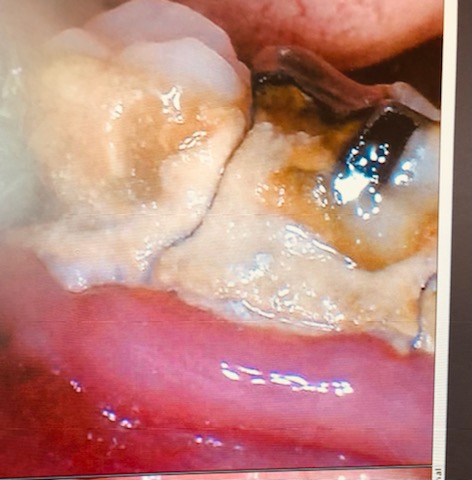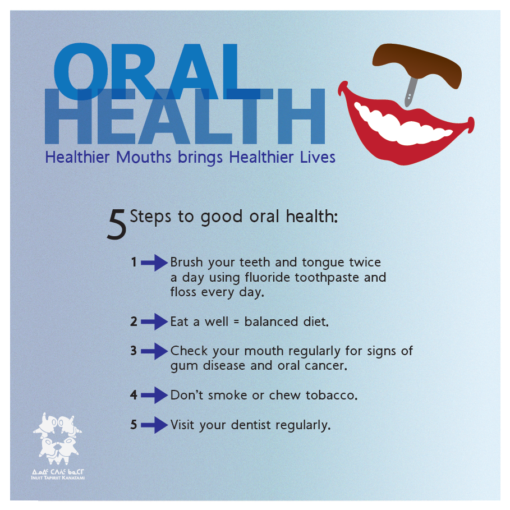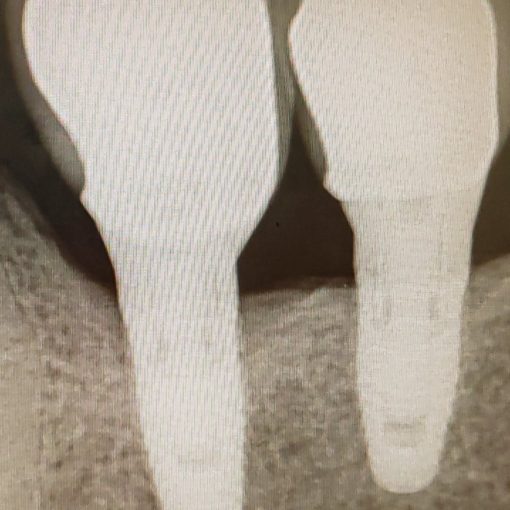Prophylaxis vs Periodontal Maintenance vs Deeper Cleaning
May people don’t know the difference of a cleanings so it prompted me to write this. They just know some are more expensive, some hurt more, and insurance doesn’t cover them well. Thats all great but the biggest issue is what’s most beneficial to you from the health perspective in the goal of keeping the teeth. There are a couple evaluations we conduct to determine the type of cleaning a person needs.
One way is through radiographs to determine bone loss and calculus build up.The below radiograph shows bone levels and loss with the white arrow. The red circle shows the calculus build up under the gums.

The other way is through measuring the gums through probing to evaluate the health of the tissue and bone. The further under the gums we can go with the probe the more tissue and bone loss there is.
We measure in millimeters:
1-3 mm is considered healthy
4 mm is considered a warning sign usually more flossing resolves this to reverse the inflammation, firm up the tissue and bring the tissue back to 3mm and lower.
5 mm and plus means the tissue that is attached to the tooth has pulled away and when the tissue recedes or pulls away the bone follows it, causing a double loss of structural support.When this happens there is more space under the gumline for food, bacteria, and plaque to accumulate and cause destruction. As this is the area where it’s just not reachable at home with normal brushing and flossing, making hte case for more importance of regular office cleanings. This is part of the evaluation along with radiographs to determine what type of cleaning is needed: prophy, periodontal maintenance or deep cleaning.
CDT CODING in dentistry is a set of codes with descriptive terms developed and updated by the American Dental Association for reporting dental services and procedures to dental insurances. These codes are how we bill the dental insurance for procedures to be paid, it’s similar to what medical has for their coding system.
Prophylaxis also referred to as prophy or regular cleaning
Prophylaxis – Adult Dental procedure code D1110
According to the CDT descriptor it applies to dental cleanings for adults. Prophylaxis as a dental prophylaxis that is performed on transitional (mixed baby and permanent) or permanent dentition. It includes scaling and/or polishing procedures to remove coronal plaque, calculus, and stains. It is a preventative measure meaning no previous or active periodontal disease and is performed on a healthy mouth with no pocketing of active bone loss.
The key word is coronal. That means the cleaning is only cleaning the crown of the tooth and above the gumline. It’s the portion of the tooth that is visible. So, it does not include under the gumline.
All honesty the cleaning is still slightly under the gumline if there is no major pocketing as determined with measuring or probing the gums.
Many people still say they only want a “regular cleaning”, because insurance considers it preventative and usually covers all the cost. It’s commonly covered twice a year or one every six months. Even some insurances, in my opinion, not enough of them will cover more of these cleanings if pregnancy or diabetes is involved.
Periodontal Maintenance
Periodontal Maintenance procedure code 4910
According to the CDT descriptor, a periodontal maintenance visit is instituted following periodontal therapy and continues at varying intervals, determined by the clinical evaluation of the dentist, for the life of the dentition or any implant replacements. It includes removal of bacterial plaque and calculus from supragingival, and subgingival regions, site-specific scaling and root planing where indicated, and polishing the teeth. If new or recurring periodontal disease appears, additional diagnostic and treatment procedures must be considered.
SO, what this simply means is it allows us dental professionals to clean under the gums as there is a history of periodontal disease and the accumulation of debris getting under the gumline. The key words are subgingival (under the gums) and site-specific root planing to allow cleaning along the root area.
This is usually recommended every 3-4 months after deeper cleanings since it takes 90 days for accumulation of bacteria to get to the bottom of the pocket and cause destruction of the tissue and bone. This is important as the tissue and bone is what holds the teeth in the mouth. The less bone and tissue create more loss of teeth.
Whereas a prophy is only coronal which is above the gumline. This procedure is recommended after a deep cleaning to still be allowed to clean the troubled areas under the gums.
A periodontal maintenance cleaning is considered maintenance under periodontal procedures and most dental insurances cover only a portion of it. Meaning there is an out-of-pocket expense to you as a patient.
Deep cleaning, quad scale, SRP (scaling and root planning)
Quad scale procedure code 4341 (1-3 teeth) localized and 4342 (4 plus teeth) generalized
This is a therapeutic procedure involving instrumentation of the crown and root surfaces of the teeth designed to remove plaque and calculus, as well as remove cementum (the outer layer of the root) and dentin (the inner layer of the tooth) that is rough, and/or permeated by calculus or contaminated with toxins or microorganisms. This usually is conducted with anesthesia as root scaling can be sensitive since the root contains the nerves. Ideally it should take a couple appointments of 1-4 visits, for a few reasons. Insurance commonly pays their portion of it if it’s not done all at once. Depending on the severity it can be pretty uncomfortable for the patient. And it’s a lot for the dental hygienist who is doing the cleaning, I’ve had a sore hand for days after, with some of these cleanings.
Deep cleaning is considered a definitive treatment in the state of periodontal disease. It may be covered to an extent but is usually not fully covered and is a good chunk with an out of pocket expense. But on the up side, this is preventable with good homecare such as daily flossing, electrical toothbrush and water pik use.
When someone only wants a “regular cleaning”, and they have periodontal disease it’s like taking a shower and only washing half your body. Leaving gunk, sweat, and bacteria in certain places lets say the pits, groin, butt, and feet region over a daily, weekly, monthly, and even yearly basis it’s only going to cause stink, rawness, infection, soreness and simply cosmetically unappealing. Not getting the appropriate cleaning, where we’re only cleaning the same surfaces that your able to clean at home can cause permanent deterioration. It’s the surfaces you can’t clean at home that we need to get to for maintenance and health.




